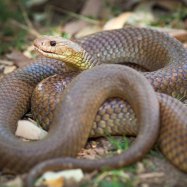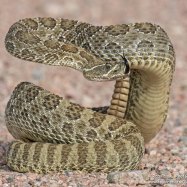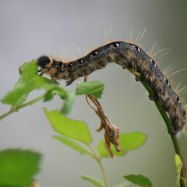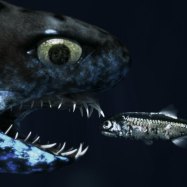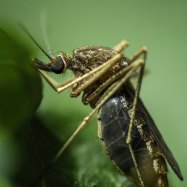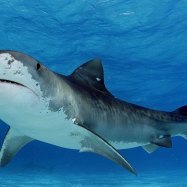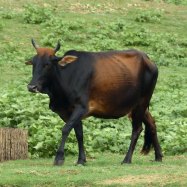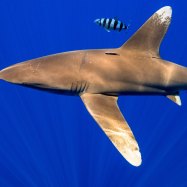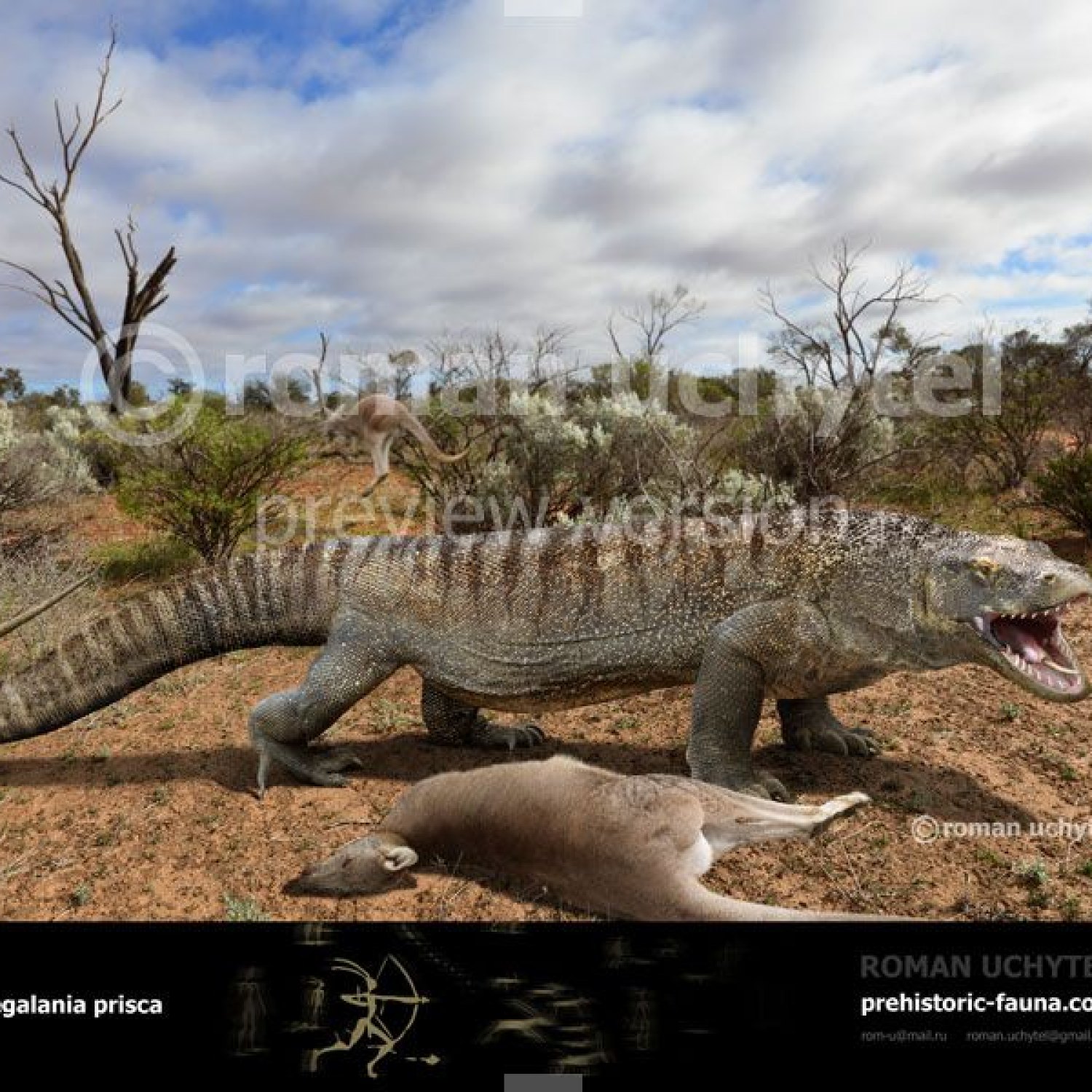
Megalania
Up to 7 meters (23 feet)
Megalania, also known as the giant ripper lizard, was a massive predator that roamed eastern and southern Australia millions of years ago. With a length of up to 7 meters, it was the largest terrestrial lizard to ever exist. Belonging to the Varanidae family, its sharp teeth and powerful jaws made it a formidable predator. Its large and elongated body shape allowed it to ambush and take down its prey with ease. Today, fossils of this incredible creature continue to amaze and fascinate scientists and animal enthusiasts alike.
Animal Details Summary:
Common Name: Megalania
Kingdom: Animalia
Habitat: Woodlands, grasslands, and scrubs
The Mighty Megalania: A Fascinating Giant of Australian Land
Amid the serene landscape of Australia’s eastern and southern regions, a powerful beast once roamed the land – a creature so large and formidable that it continues to capture the imagination of people today. This animal, known as the Megalania, was a true giant of the reptile world measuring up to 7 meters (23 feet) in length. With its giant size, impressive appearance and unique features, it’s no wonder that the Megalania continues to pique the interest of scientists and animal enthusiasts alike.The Classification of the Megalania
The Megalania, scientifically known as Varanus priscus, belonged to the kingdom Animalia, the phylum Chordata, and the class Reptilia Megalania. It was a member of the order Squamata, which includes snakes and lizards, and the family Varanidae, which makes it a relative of today’s fearsome Komodo dragons. Its name "Varanus" comes from the Latin word "Varus" meaning "wise", and "priscus" meaning "ancient". As such, the Megalania is also commonly referred to as “ancient monitor lizard” or “giant ripper lizard”.Often confused with another giant lizard species, the Megalania is not to be mistaken with the Megalania prisca, which walked the Earth approximately 600,000 years ago. While they share similar physical traits and characteristics, they are believed to be two distinct species.
Habitat and Distribution
The Megalania's reign was limited to the Australian land, and it was believed to have inhabited the woodlands, grasslands, and scrubs of eastern and southern regions. These areas offered a favorable climate for its survival, with temperate conditions and suitable prey. The Megalania was also an excellent climber and could have been found lurking in trees, waiting for an opportune moment to hunt its prey.Researchers have found fossils of the Megalania mainly in the eastern and southern parts of Australia, particularly in Queensland, New South Wales, Victoria, and South Australia Minke Whale. However, there is evidence that suggests it may have ventured out to the coastal regions as well.
Appearance and Physical Characteristics
One of the most striking features of the Megalania was its impressive size. It is believed to have been one of the largest land-dwelling lizards that ever existed. Its size was comparable to that of a large saltwater crocodile, and it was estimated to weigh around 800 kilograms (1764 pounds). Its unique and robust body structure was built for agility and power, making it a formidable predator.The Megalania shared a similar appearance to modern-day monitor lizards, with rough-textured skin and sharp claws. Its body was elongated and featured four powerful legs, which allowed it to move quickly and smoothly. Its tail, which could reach up to half its total body length, was used for balance and defense against predators.
Feeding Habits
The Megalania was a carnivorous species, meaning it primarily fed on meat. Its diet consisted mainly of smaller mammals and reptiles such as kangaroos, wombats, and other lizards. Its large size and incredible strength allowed it to overpower even the biggest of prey with ease. Its sharp teeth and powerful jaw also played a crucial role in securing its meals.The Megalania is believed to have been an opportunistic hunter, meaning it would take advantage of whatever food was available in its surroundings. It would often hide in trees, waiting for its prey to pass by, and would then use its incredible speed and agility to pounce and subdue its victim.
Unique Characteristics
The Megalania was a truly unique creature, possessing features that set it apart from other reptiles of its time. One of its most distinctive attributes was its venom glands, similar to those found in today’s Komodo dragons. These glands were located in the Megalania’s lower jaw and were used to inject venom into its prey, making it a more effective hunter.Unlike other lizards who shed their tails for defense, the Megalania’s tail was not easily detachable. Instead, it had thick, bony rods that ran along its tail, providing it with strength and rigidity. Additionally, its skin was known to be thicker, rougher, and more resilient than that of its reptile counterparts. All these unique features made the Megalania one of the most formidable predators of its time.
Extinction of the Megalania
The Megalania existed during the Pleistocene Epoch, which lasted from about 2.5 million to 11,700 years ago. Unfortunately, this time was marked by significant changes in the climate and environment, leading to the extinction of many species. Along with the Megalania, many other creatures such as the woolly mammoth and saber-toothed cat, perished during this period.The exact reason for the Megalania’s extinction remains unclear, but it is believed that the change in climate, along with the arrival of humans and other large predators, played a significant role. Additionally, the Megalania’s limited distribution may have also impacted its ability to adapt to these changes.
Unanswered Questions and Theories
Despite the vast research and discoveries made about the Megalania, there are still many unanswered questions and theories surrounding this giant reptile. One of the most significant debates among scientists is whether the Megalania was a terrestrial or arboreal species. Some evidence suggests that it may have been a land-dwelling creature, while others believe that due to its strong claws and powerful tail, it may have been an excellent climber and spent much of its time in trees.Another intriguing theory is that the Megalania may still exist today. There have been several reports of sightings of large lizard-like creatures in Australia, which some believe could be remnants of this ancient species. However, there is no scientific evidence to prove this theory, and it remains a mystery.
In Conclusion
The Megalania remains an enigma, and its existence has captured the interest of scientists, researchers, and animal enthusiasts for centuries. With its massive size, unique features, and mysterious extinction, it continues to be a subject of fascination and speculation. Although it may no longer roam the Earth, the Megalania’s legacy and impact on the Australian ecosystem will never be forgotten.

Megalania
Animal Details Megalania - Scientific Name: Varanus priscus
- Category: Animals M
- Scientific Name: Varanus priscus
- Common Name: Megalania
- Kingdom: Animalia
- Phylum: Chordata
- Class: Reptilia
- Order: Squamata
- Family: Varanidae
- Habitat: Woodlands, grasslands, and scrubs
- Feeding Method: Carnivorous
- Geographical Distribution: Australia
- Country of Origin: Australia
- Location: Eastern and southern Australia
- Animal Coloration: Varies from brown to gray or black
- Body Shape: Large and elongated
- Length: Up to 7 meters (23 feet)
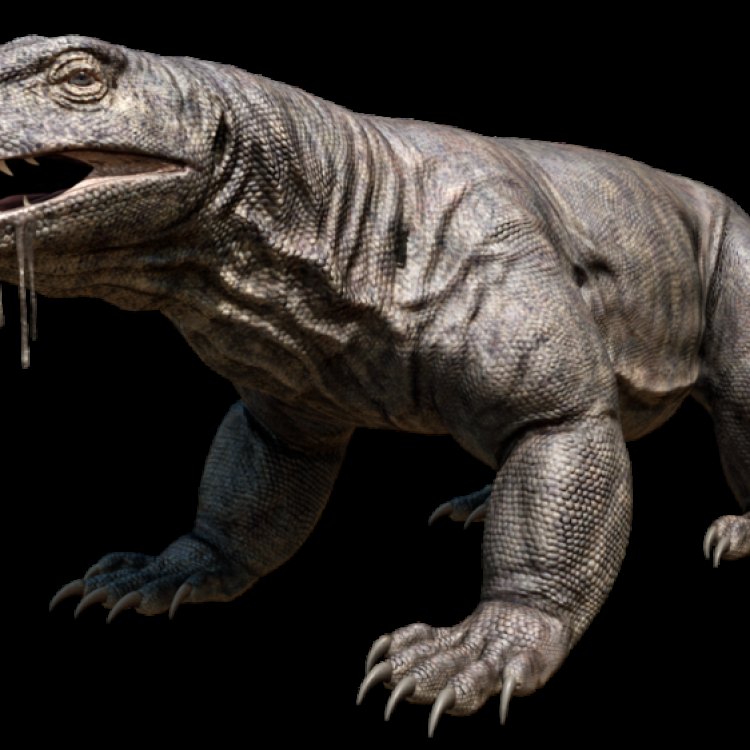
Megalania
- Adult Size: Large
- Average Lifespan: Unknown
- Reproduction: Oviparous (lays eggs)
- Reproductive Behavior: Mating occurs during the spring
- Sound or Call: Unknown
- Migration Pattern: Non-migratory
- Social Groups: Solitary
- Behavior: Active during the day
- Threats: Extinct
- Conservation Status: Extinct
- Impact on Ecosystem: Unknown
- Human Use: None
- Distinctive Features: Large size and powerful jaws
- Interesting Facts: Megalania was the largest terrestrial lizard that ever lived
- Predator: Top predator
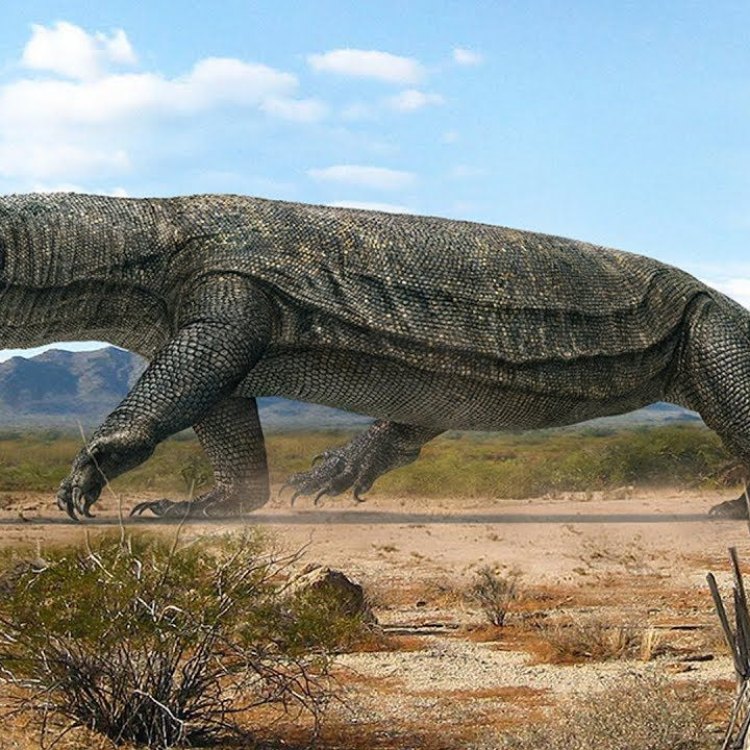
Varanus priscus
The Mighty Megalania: The Largest Terrestrial Lizard To Ever Roam The Earth
When you think of giant lizards, the first thing that may come to mind is the popular Komodo Dragon. However, there once existed an even bigger and more formidable lizard, known as the Megalania. This prehistoric beast was a true giant, and its presence dominated the Australian landscape during the Pleistocene era, approximately 1.6 million to 10,000 years ago PeaceOfAnimals.Com. In this article, we'll take a closer look at the unique features and interesting facts of the Megalania, the largest terrestrial lizard that ever lived.Adult Size and Distinctive Features
Megalania was an enormous creature, with an average length of 7 meters (23 feet) and a weight of 600-1000 kg (1300-2200 pounds). For comparison, the modern Komodo Dragon averages a length of 2-3 meters and a weight of 70 kg (150 pounds). This makes the Megalania three times larger than its modern-day cousin, and the largest land-dwelling lizard ever recorded.
One of the most distinctive features of Megalania was its massive size and powerful jaws. Its teeth were sharp, curved, and serrated, which made it an efficient predator. Its large size also gave it a significant advantage over its prey, making it a top predator in its ecosystem. Unlike its smaller relatives, Megalania had larger body proportions and could walk on all four legs, similar to modern-day crocodiles.
Behavior and Reproduction
Megalania was an active and diurnal (daytime) creature, meaning it hunted and roamed during daylight hours Mouse Spider. This is in contrast to its modern-day relatives, which are mostly nocturnal (active at night). Being active during the day gave the Megalania an advantage over its prey, as many of its potential targets were also active during this time.
Mating among Megalania occurred during the spring, reflecting seasonal mating patterns similar to many modern-day reptiles. With little information available on their reproductive behavior, it is believed that they laid eggs, making them oviparous. Scientists have found fossils of eggs and hatchlings, providing evidence of their reproductive behavior.
Social Groups and Migration Pattern
Contrary to many lizards, which may live in groups or colonies, Megalania was solitary and most likely had no social groups. This could be due to their large size, making it difficult to find enough resources to sustain a larger group. It is also believed that Megalania was a non-migratory species, meaning they did not make regular long-distance movements, unlike some modern-day reptiles.
Threats and Conservation Status
Unfortunately, Megalania was unable to survive the harsh conditions and changes in its environment, leading to its extinction. Scientists believe that the arrival of humans may have been a contributing factor, as humans settled in Australia around the same time as Megalania's decline. This could have led to competition for resources and even direct human activity, leading to its demise.
Today, the conservation status of Megalania is considered extinct. While some people may see this as a tragedy, it's important to remember that extinction is a natural process in the life cycle of all species. However, understanding the factors that contributed to the extinction of Megalania can help us learn valuable lessons in conservation and preserving our modern-day wildlife.
Impact on the Ecosystem
The exact impact of Megalania on its ecosystem remains unknown, as valuable information is limited. However, we can speculate that as a top predator, it played a crucial role in maintaining balance and stability in its environment. Its diet could have consisted of large mammals, such as kangaroos, as well as other reptiles and birds. The extinction of Megalania may have potentially led to changes in the food chain and affected the biodiversity of its ecosystem.
Human Use
Despite its powerful and intimidating size, Megalania had no practical use for humans. This could be due to its limited distribution and the fact that it went into extinction long before humans fully settled in Australia.
Interesting Facts
Apart from its impressive size, there are many other interesting facts about Megalania. For instance, it is believed that they had excellent senses, including sight, smell, and hearing, making them efficient predators. They were also one of the last surviving giant lizards, with their extinction signaling the end of megafauna in Australia. Additionally, Megalania was not a dinosaur, but rather a type of monitor lizard, a group that includes the popular Komodo Dragon.
In modern-day Australia, there have been many reported sightings of giant lizards, often referred to as "Megalania hunters." Still, there is no concrete evidence to support these sightings, and many believe them to be simply hoaxes.
The Legacy of Megalania
Although Megalania is extinct, its legacy lives on through fossils and scientific studies. It offers a window into the past and helps us understand the evolution of lizards and other animals throughout history. Its incredible size and unique features make it a fascinating topic for researchers and a source of inspiration for writers and filmmakers.
In conclusion, Megalania is a remarkable creature that once roamed the Australian landscape and ruled as the largest terrestrial lizard to ever exist. Despite its extinction, it will forever hold a special place in the world of paleontology and continue to capture our imagination and curiosity. Its story is a powerful reminder of the wonders and mysteries that lie within our natural world, waiting to be discovered.
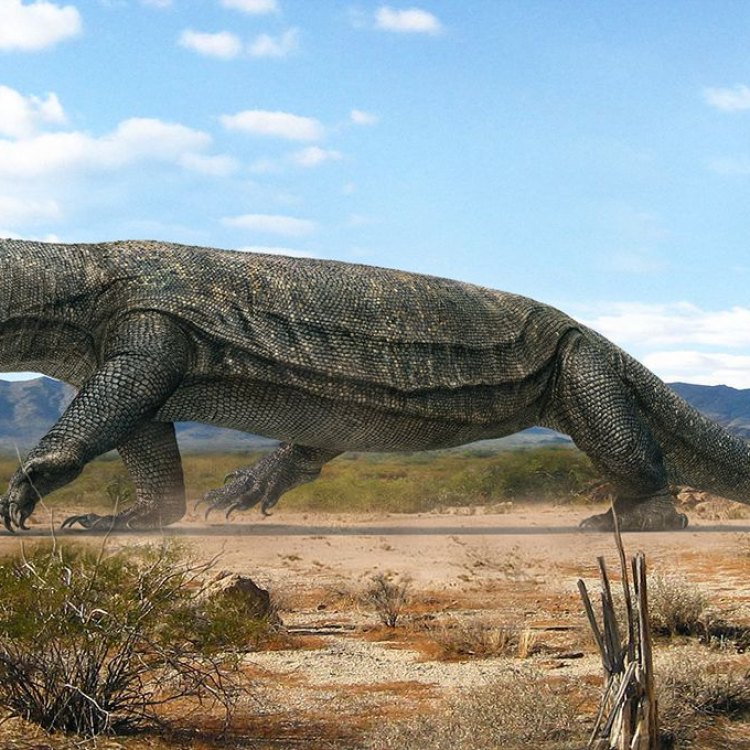
The Mighty Megalania: A Fascinating Giant of Australian Land
Disclaimer: The content provided is for informational purposes only. We cannot guarantee the accuracy of the information on this page 100%. All information provided here may change without prior notice.

